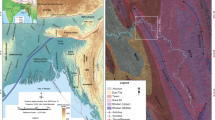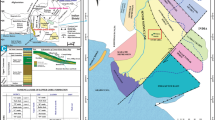Abstract
The deformed sedimentary sequence exposed in the core of Precambrian Kaladgi Basin, North Karnataka India, has given rise to prominent regional basinal structures with intervening anticlines. Deformation ceases away from the core part. The basinal structures are recognised on satellite images, aerial photographs and toposheets because of resistant segmented ridges of quartzite. A closure view of Bhuvan images around Yadwad village, North Karnataka, the core portion of Kaladgi Basin also revealed presence of folded geometry in the older carbonates of Bagalkot Group seen along the margins of the regional folds. Though folding in the sequence exposed in the region around Yadwad and further west is described by many authors, no detailed analysis of structures is available in published literature. An attempt is made here to map, analyse and integrate the structures in carbonates of Yadwad region on different scales observed in the field to find out their possible origin. It is suggested that the structures are syntectonic in origin formed in the presence of circulating fluids in high pressure and low temperature during the post depositional phase the Bagalkot sequence in which gravity played an important role in the formation of regional structures. The sequence also has recorded low grade of metamorphism as seen from the thin section observations.

















Similar content being viewed by others
References
Awati, & Kalaswad (1980). Structure of the Kaladgis around Yadwad, Belgaum district (A study based on Landsat- I). Bull Earth Sci, 6(1), 43–47.
Bastida, F., Aller, J., Bobillo-Ares, N. C., & Toimil, N. C. (2005). Fold geometry; a basis for their kinematical analysis. Earth-Science Reviews, 70, 129–164.
Bles, J. L., & Feuga, B. (1986). The fracture of rocks. London: North Oxford Academic 131 pp.
Cosgrove, J. W., & Ameen, M. S. (2000). Forced folds and fractures. Geological Society, London, Special Publications, 169, 7–21.
Dey, S., Rai, A. K., & Chaki, A. (2009). Palaeoweathering, composition and tectonics of provenance of the Proterozoic intracratonic Kaladgi–Badami basin, Karnataka, southern India: evidence from sandstone petrography and geochemistry. Journal of Asian Earth Sciences, 34, 703–715.
Donath, F. A., & Parker, R. B. (1964). Folds and folding. Geological Society of America Bulletin, 75, 45–62.
Einsele, G. (1992). Sedimentary basins, evolutions, facies and sediment budget. Berlin: Springer Verlag 632 pp.
Foote, R. B. (1876). Geological features of the south Maharatta country and adjoining districts. Memoirs - Geological Survey of India, 12(2), 70–138.
Fossen, H. (2010). Structural geology. London: Cambridge University Press, 481 pp.
Ghosh, S. K. (1994). Structural geology: Fundamentals and modern developments. Oxford: Pergamon.
Gratier, J. P. (1987). Pressure solution deposition creep and associated tectonic differentiation in sedimentary rocks. Geological Society of London, Special Pblication, 29, 25–38.
Huddleston, P. J. (1973). Fold morphology and some geometrical implications of theories of fold development. Tectonophysics, 16, 1–46.
Huddleston, P. J., & Treagus, S. H. (2010). Information from folds: a review. Journal of Structural Geology, 32(2010), 2042–2071.
Jadhav, P.B. (1987). Microstructures of Quartzites of Yadwad- Lokapur and Bagalkot area, Bjpaur District, North Karnataka. Unpublished PhD thesis, Pune University, 204 pp
Jadhav, P. B. (1999) Deformational structures in the Precambrian sedimentary sequence of sedimentary sequence of Yadwad – Lokapur – Bagalkot area, North Karnataka Geo.Soc. India, Field Workshop,32p.
Jayaprakash, A. V. (2007). Purana Basins of Karnataka. Memoirs - Geological Survey of India, 129, 140.
Jayaprakash, A. V., Sundaram, V., Hans, S. K., & Mishra, R. N. (1987). Geology of the Kaladgi– Badami Basin, Karnataka. Memoirs - Geological Society of India, 6, 201–226.
Jones, M. E., & Preston, R. M. F. (1987). Deformation of sediments and sedimentary rocks. Geological Society of London, Special Publication, 29, 550.
Kale, V. S., & Phansalkar, V. G. (1991). Purana basins of Peninsular India: a review. Basin Research, 3, 1–36.
Kale, V. S., & Pillai, P. S. (2011). A Reinterpretation of two Chertbreccias from the Proterozoic Basins of India. Journal of the Geological Society of India, 78, 429–445.
Ord, Alison, and Hobbs, Bruce (2012). Localised folding in general deformations. Tectonophysics 1–15.
Pillai, Patil S. (2005). Testimony of sedimentation and structural patterns of the Bagalkot-Simikeri area on the evolution of the Proterozoic Kaladgi Basin. Unpubl. Ph.D. Thesis, Pune Univ., Pune.
Pillai, P. S., & Kale, V. S. (2011). Seismites in the Lokapur subgroup of the Proterozoic Kaladgi Basin, South India: a testimony to syn-sedimentary tectonism. Sedimentary Geology, 240(2011), 1–13.
Ramsay, J. G. (1967). Folding and fracturing of rocks. New York: McGraw Hill 567 pp.
Ramsay, J. G., & Huber, M. I. (1987). The techniques of modern structural geology, volume 2, folds and fractures. London: Academic Press 406 pp.
Sathyanarayan, S., & Mijller, G. (1978). Origin of Nodular Chert in the Carbonate Rocks of the Kaladgi Group (Younger Precambrian), Karnataka, India. Sedimentary Geology, 25(1980), 209–221.
Stearns, D. W. (1978). Faulting and forced folding in the Rocky Mountains foreland. In Matthews, V., Ill, (Ed.), Laramide folding associated with basement block faulting in the Western United States (pp. 1–38). Boulder, Colorado: Geological Society of America Memoir.
Twiss, R. J. (1988). Description and classification of folds in single surfaces. Journal of Structural Geology, 10, 607–623.
Twiss, R. J., & Moore, E. M. (1992). Structural geology (Second ed.). USA: Freeman and Company 742 pp.
van der Pluijm, B. A., & Marshak, S. (2004). Earth structure: an introduction to structural geology and tectonics (Second ed.). Norton & Company: US 673 pp.
Vishwanathiah, M. N. (1968). Badami series: a new post-Kaladgi formation of Karnataka state. Bulletin Geological Society of India, 5, 94–97.
Acknowledgments
The authors are thankful to Prof V D Karad, President and Executive Director of MAEERs Maharashtra Institute of Technology. They express their gratitude to late Prof Anant V Phadke for teaching finer aspect of structural geology. They thank Prof V V Peshwa, Prof V G Phansalkar for timely guidance and also Dr. Vivek Kale for critical comments.
Author information
Authors and Affiliations
Corresponding author
About this article
Cite this article
Jadhav, P.B., Kshirsagar, L.K. Analysis of Folding in the Proterozoic Sedimentary Sequence of Bagalkot Group Exposed around Yadwad, N Karnataka, India: a Study Based on Remote Sensing Techniques and Field Investigations. J Indian Soc Remote Sens 45, 247–258 (2017). https://doi.org/10.1007/s12524-016-0583-4
Received:
Accepted:
Published:
Issue Date:
DOI: https://doi.org/10.1007/s12524-016-0583-4




